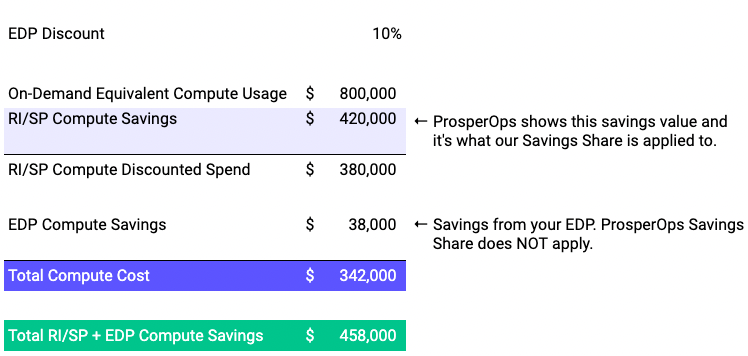How are RI and SP Savings Calculations Impacted by an EDP?
What is an EDP?
For customers with sufficient spend, AWS makes available an Enterprise Discount Program (EDP, aka Cross-Service Private Pricing Agreement) which enables a flat discount on overall AWS spend in exchange for a long-term spend commitment.
Using RIs and SPs with an EDP
RI/SP discounts and EDP discounts stack, which means you can receive discounts from both savings programs at the same time! In that scenario, it's valuable to separate and properly account for RI/SP savings and EDP savings. This becomes critical with a service like ProsperOps since our Savings Share is specifically a function of the RI/SP savings generated.
Authoritative System of Record
As discussed in this article, ProsperOps considers AWS the authoritative system of record for RI and SP savings. This is true of EDP savings as well. As such, our savings calculations follow AWS' methodology for how RI/SP and EDP discounts are applied. This ensures the savings values shown in our Console always match the authoritative savings values from AWS.
AWS Discount Order of Operations
When the AWS billing system applies discounts, RI and SP discounts are applied first. Specifically, AWS calculates RI and SP savings upstream of whatever EDP discount is applied later in the billing process. This means RI and SP savings, as reported by AWS, are the difference between spend with list RI and SP rates vs. spend if compute ran at list on-demand rates. This savings value is what our service impacts and is thus what our Savings Share is applied to.
Once RI and SP savings are applied, AWS then applies the EDP discount to the RI/SP compute discounted spend amount. EDP savings are additive above and beyond RI and SP savings and fully accrue to the customer. Our Savings Share does NOT apply to EDP savings.
AWS Savings Calculation Example
This example illustrates how AWS applies discounts and calculates savings. ProsperOps follows AWS as the authoritative system of record for RI/SP and EDP savings values.

